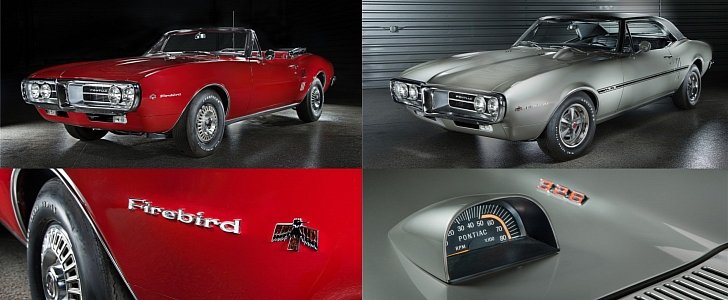After General Motors had caught up to the Ford Mustang with the introduction of the Chevrolet Camaro, Pontiac wanted a piece of the action as well. And so, the second F-Body model was born in the form of the Pontiac Firebird. Believe it or not, the first two examples of this particular breed are now heading to auction.
Barrett-Jackson will handle the sale of VIN #100001 (red-painted convertible) and VIN #100002 (silver-painted coupe). Both cars will find themselves new owners this coming October, at the Barrett-Jackson Las Vegas auction. And yes, both are offered at no reserve. Considering that the combo was bought for $70,000 from former NBA basketball player Chuck Alekinas, I have this feeling that the gavel will drop after the auctioneer shouts a six-figure sum.
The cars are part of the “Firebird Magnificent Five” quintet, vehicles used to promote the Firebird throughout the United States. Discovered in a barn by Gas Monkey Garage roughly two years ago, #100001 and #100002 were in pretty bad shape. But after a money-no-object nut-and-bolt restoration, the Firebirds we're talking about today have been given a new chance at life.
Manufactured at Pontiac Lordstown in Ohio in early 1967, the body tags are labeled "Show Body 1" on the convertible and "Show Body 4" on the coupe. From a mechanical standpoint, the two share a 326 cu. in. (5.3-liter) Pontiac V8 engine gifted with a four-barrel carburetor and 285 horsepower. Regarding the duty of swapping cogs, the convertible Firebird is equipped with a 3-speed Turbo-Hydramatic, while the Firebird coupe boasts a 4-speed manual.
If it weren’t for John DeLorean’s roles as vice president of General Motors, the Firebird wouldn’t have been born into this world. The decision to make a Pontiac-branded equivalent of the Chevrolet Camaro was taken for a very simple reason: the pony car movement that took the American automotive scene by storm in the swinging ‘60s. These days, with all the Hellcats, ZL1s, and GT350s out there, we’re witnessing a renaissance of that crazy era.
So there you have it. Oh, and another thing that needs to be mentioned: in the listings for both Firebird originals, the fine print reads “sold as a pair.”
The cars are part of the “Firebird Magnificent Five” quintet, vehicles used to promote the Firebird throughout the United States. Discovered in a barn by Gas Monkey Garage roughly two years ago, #100001 and #100002 were in pretty bad shape. But after a money-no-object nut-and-bolt restoration, the Firebirds we're talking about today have been given a new chance at life.
Manufactured at Pontiac Lordstown in Ohio in early 1967, the body tags are labeled "Show Body 1" on the convertible and "Show Body 4" on the coupe. From a mechanical standpoint, the two share a 326 cu. in. (5.3-liter) Pontiac V8 engine gifted with a four-barrel carburetor and 285 horsepower. Regarding the duty of swapping cogs, the convertible Firebird is equipped with a 3-speed Turbo-Hydramatic, while the Firebird coupe boasts a 4-speed manual.
If it weren’t for John DeLorean’s roles as vice president of General Motors, the Firebird wouldn’t have been born into this world. The decision to make a Pontiac-branded equivalent of the Chevrolet Camaro was taken for a very simple reason: the pony car movement that took the American automotive scene by storm in the swinging ‘60s. These days, with all the Hellcats, ZL1s, and GT350s out there, we’re witnessing a renaissance of that crazy era.
So there you have it. Oh, and another thing that needs to be mentioned: in the listings for both Firebird originals, the fine print reads “sold as a pair.”
















